RANSOM_CRYPJOKER.A
Windows


Threat Type: Trojan
Destructiveness: No
Encrypted: Yes
In the wild: Yes
OVERVIEW
This Trojan arrives as an attachment to email messages spammed by other malware/grayware or malicious users. It may be unknowingly downloaded by a user while visiting malicious websites.
It gathers information and reports it to its servers.
TECHNICAL DETAILS
Arrival Details
This Trojan arrives as an attachment to email messages spammed by other malware/grayware or malicious users.
It may be unknowingly downloaded by a user while visiting malicious websites.
Installation
This Trojan drops the following files:
- %User Temp%\crjoker.html
- %User Temp%\README!!!.txt
- %User Temp%\GetYouFiles.txt
- %Desktop%\readme.txt
- %Desktop%\READ.txt
- %Desktop%\read this file.txt
- %Desktop%\READ NOW.txt
- %Desktop%\README!!!.txt
- %Desktop%\ПРОЧТИ.txt.txt
- %Desktop%\РАСШИФРОВАТЬ ФАЙЛЫ.txt
- %Desktop%\DECRYPT FILES.txt
- %Desktop%\GET MY FILES.txt
- %AppData%\README!!!.txt22
(Note: %User Temp% is the user's temporary folder, where it usually is C:\Documents and Settings\{user name}\Local Settings\Temp on Windows 2000, Windows Server 2003, and Windows XP (32- and 64-bit); C:\Users\{user name}\AppData\Local\Temp on Windows Vista (32- and 64-bit), Windows 7 (32- and 64-bit), Windows 8 (32- and 64-bit), Windows 8.1 (32- and 64-bit), Windows Server 2008, and Windows Server 2012.. %Desktop% is the desktop folder, where it usually is C:\Documents and Settings\{user name}\Desktop in Windows 2000, Windows Server 2003, and Windows XP (32- and 64-bit); C:\Users\{user name}\Desktop in Windows Vista (32- and 64-bit), Windows 7 (32- and 64-bit), Windows 8 (32- and 64-bit), Windows 8.1 (32- and 64-bit), Windows Server 2008, and Windows Server 2012.)
It drops the following component file(s):
- %User Temp%\drvpci.exe – terminates taskmgr and regedit
- %User Temp%\windefrag.exe – drops ransom note and displays ransom window
- %User Temp%\winpnp.exe – connects to URL to report system information
- %User Temp%\windrv.exe – downloads a file from a URL
- %User Temp%\new.bat – removes shadow copies and disables Window startup repair
- %User Temp%\sdajfhdfkj
(Note: %User Temp% is the user's temporary folder, where it usually is C:\Documents and Settings\{user name}\Local Settings\Temp on Windows 2000, Windows Server 2003, and Windows XP (32- and 64-bit); C:\Users\{user name}\AppData\Local\Temp on Windows Vista (32- and 64-bit), Windows 7 (32- and 64-bit), Windows 8 (32- and 64-bit), Windows 8.1 (32- and 64-bit), Windows Server 2008, and Windows Server 2012.)
Other System Modifications
This Trojan modifies the following file(s):
- appends the extension .crjoker to the encrypted files
Process Termination
This Trojan terminates the following processes if found running in the affected system's memory:
- taskmgr
- regedit
Other Details
This Trojan encrypts files with the following extensions:
- .txt
- .doc
- .docx
- .xls
- .xlsx
- .ppt
- .pptx
- .odt
- .jpg
- .png
- .csv
- .sql
- .mdb
- .sln
- .php
- .asp
- .aspx
- .html
- .xml
- .psd
- .java
- .jpeg
- .pptm
- .pptx
- .xlsb
- .xlsm
- .db
- .docm
- .sql
It gathers the following information and reports it to its servers:
- host name
- IP address
- username
- machine name
NOTES:
This malware adds the following autorun registry entries to enable automatic execution of its dropped components every system startup:
HKEY_CURRENT_USER\Software\Microsoft\Windows\CurrentVersion\Run
winpnp data = "%User Temp%\winpnp.exe"
HKEY_CURRENT_USER\Software\Microsoft\Windows\CurrentVersion\Run
drvpci = "%User Temp%\drvpci.exe"
HKEY_CURRENT_USER\Software\Microsoft\Windows\CurrentVersion\Run
windefrag = "%User Temp%\windefrag.exe"
The component windrv.exe downloads a possibly malicious file from the URL http://{BLOCKED}v.de/wp-content/plugins/libravatar-replace/statistic.exe. However, as of this writing, the server does not host the file.
It is expected to save and execute the downloaded file as %User Temp%\imgdesktop.exe.
It displays the following window showing the ransom note:
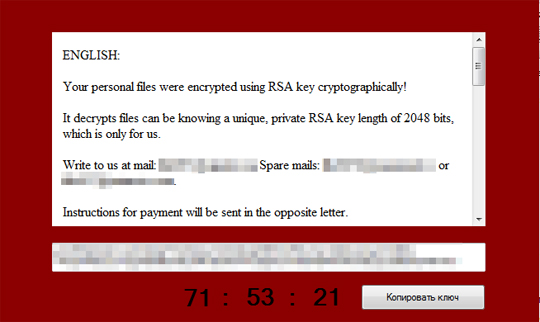
The dropped ransom notes contain the following information once opened by the user:
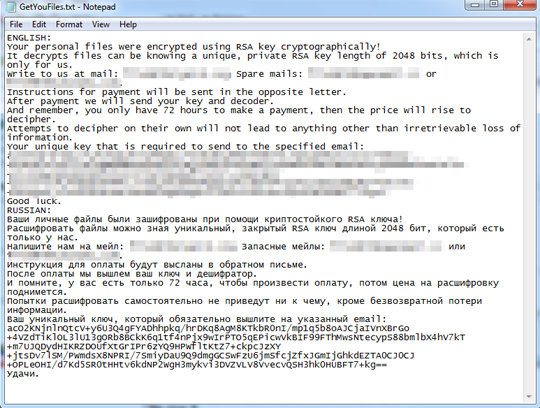


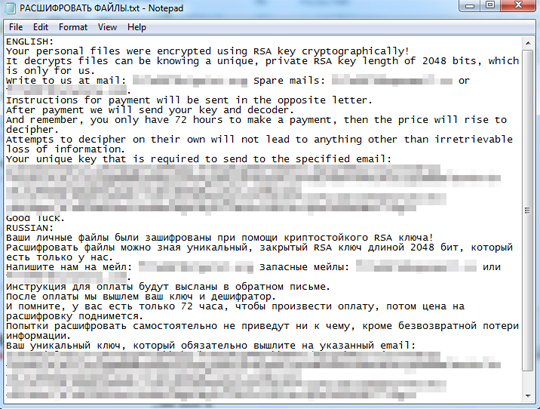
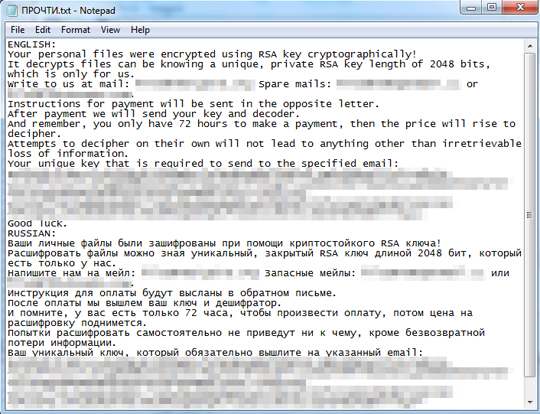
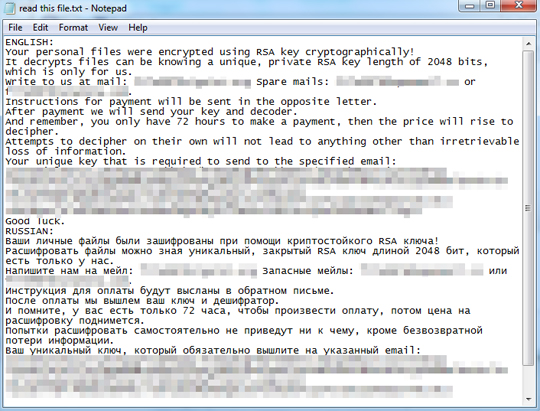

SOLUTION
Step 1
Before doing any scans, Windows XP, Windows Vista, and Windows 7 users must disable System Restore to allow full scanning of their computers.
Step 2
Note that not all files, folders, and registry keys and entries are installed on your computer during this malware's/spyware's/grayware's execution. This may be due to incomplete installation or other operating system conditions. If you do not find the same files/folders/registry information, please proceed to the next step.
Step 3
Restart in Safe Mode
Step 4
Delete this registry value
Important: Editing the Windows Registry incorrectly can lead to irreversible system malfunction. Please do this step only if you know how or you can ask assistance from your system administrator. Else, check this Microsoft article first before modifying your computer's registry.
- In HKEY_CURRENT_USER\Software\Microsoft\Windows\CurrentVersion\Run
- winpnp data = "%User Temp%\winpnp.exe"
- winpnp data = "%User Temp%\winpnp.exe"
- In HKEY_CURRENT_USER\Software\Microsoft\Windows\CurrentVersion\Run
- drvpci = "%User Temp%\drvpci.exe"
- drvpci = "%User Temp%\drvpci.exe"
- In HKEY_CURRENT_USER\Software\Microsoft\Windows\CurrentVersion\Run
- windefrag = "%User Temp%\windefrag.exe"
- windefrag = "%User Temp%\windefrag.exe"
Step 5
Search and delete this file
- %User Temp%\crjoker.html
- %User Temp%\README!!!.txt
- %User Temp%\GetYouFiles.txt
- %Desktop%\readme.txt
- %Desktop%\READ.txt
- %Desktop%\read this file.txt
- %Desktop%\READ NOW.txt
- %Desktop%\README!!!.txt
- %Desktop%\ПРОЧТИ.txt.txt
- %Desktop%\РАСШИФРОВАТЬ ФАЙЛЫ.txt
- %Desktop%\DECRYPT FILES.txt
- %Desktop%\GET MY FILES.txt
- %AppData%\README!!!.txt22
- %User Temp%\imgdesktop.exe
Step 6
Restart in normal mode and scan your computer with your Trend Micro product for files detected as RANSOM_CRYPJOKER.A. If the detected files have already been cleaned, deleted, or quarantined by your Trend Micro product, no further step is required. You may opt to simply delete the quarantined files. Please check this Knowledge Base page for more information.
Step 7
Restore this file from backup only Microsoft-related files will be restored. If this malware/grayware also deleted files related to programs that are not from Microsoft, please reinstall those programs on you computer again.
- encrypted files with .crjoker extension
Did this description help? Tell us how we did.


